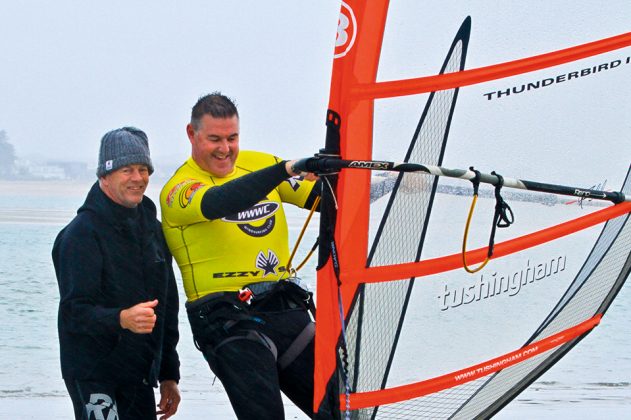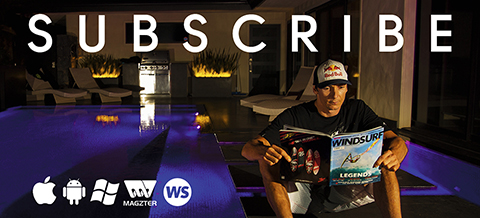BIG MEN, SMALL PROBLEMS
Words Peter Hart // Photos Simon Bassett/2XS,
Hart Photography, Brett Kenny & Richard Whitson.
Across the range of human forms, it’s really big men who struggle the most when it comes to mastering windsurfing’s upper levels. However, with smart kit selection, smart tuning and a fresh approach to technique, the problems are far from insurmountable – as Peter Hart explains
“People without children, you may imagine what it’s like to have them – but you’ll never really know – the way they connect you with your past and your future, the sense of blood, genetics, heritage, the depth of emotions, the unconditional love, the moments of clawing frustration and unremitting joy. So, in the same way, listen you 55 kg, 19 year old RYA instructor girl – don’t even pretend to know what it’s like to try and windsurf with 80 bags of sugar on your back. What advice can you possibly give me on sail and board size and type? I’m over twice your weight. What you’re into is posing about on your 90 litre freestyle board and 4.7 in a force 4. What I’m into is getting on, getting going and getting back on a sail 4 sq m bigger. There’s nothing you can tell me!” Such was the hilarious and despairing rant of 120 kg John Issit, lecturer and author (hence the literary beauty of his outburst) and very keen windsurfer – very keen and yet like many with XXXL underpants, very frustrated by his lack of progress compared to his less voluminous peers, which he puts down entirely to his size.
He has a point. Due to simple bio-mechanics and available equipment, larger than average people appear to start behind the 8 ball. We’re going to identify the disadvantages and then overcome them. It may seem a bit much to dedicate a whole article to the woes of the large. However, dealing with an extreme often brings key issues into sharper focus. Everything we’re about to discuss here concerning kit, tuning, attitude and technique, is relevant to all.
Power and weight
Windsurfing is not a pure strength sport. What counts is strength relative to weight, which in turn determines how quickly and effectively you can shift your mass. That’s what we do to get planing. Lighter people naturally have a better strength to weight ratio. In the 60 kg weightlifting class, there are athletes who can lift three times their bodyweight. In the 105 kg class they struggle to lift twice their bodyweight.
In Olympic windsurfing where everyone uses the same sail size, 72 kgs seems to be the maximum weight for men (about 57 kgs for women). Over that you have to be exponentially a lot stronger to justify every kg, which is crucial in the on/off planing conditions where you literally have to row you and your craft along. In slalom you can tool up according to your size. And it all happens maxed out on the plane at which point extra kilos can be used for a dynamic advantage. However, beyond about 95 kg, extra weight is hard to justify and becomes an unnecessary burden, especially when it comes to early planing and acceleration around the lower wind limit. Freestyle and wave sailing are all about explosive power – it’s aqua gymnastics. Very few competitive gymnasts are taller than 5’ 5” and most are under 60kg – the women considerably smaller. To be small is to have a mechanical advantage when it comes to bouncing and rotating. The top freestylers are not midgets, but few are over 83 kg.
To excel, the stark reality is that big blokes need to learn to sail relatively much smaller boards and rigs than the average man.
Inappropriate kit
The main problem for the supersizers is that simply scaling up board and rig size doesn’t really work, as we shall see. A good medium wind, ‘learning-to-plane’ combo for a 75 kg adult would be a 130 and a 6.5. To get the same reserve volume and relative power, a 120 kg chap would need a 175 litre board and a 9.0 sail.
That’s a lot of kit. He may have the bulk to sit on a 9.0 but is unlikely to have the strength to lift it and work it. Taking it up a level into the waves, a good all-round wave board for on and off the plane performance is your weight plus about 10 in litres. They don’t make a 140 litre wave board. Even if they did, it wouldn’t fit on most wave faces.
Things are rarely as drastic as they first appear. Big men can and do windsurf brilliantly. It just takes change. They have to close their ears to accepted wisdom as well as their own little voices. They have to change their view of themselves; and their relationship with the conditions and the equipment.
THE BIG LINE UP
For the purpose of this study I have called on three willing big men from various backgrounds.
John Issit (118 kg), the provider of the opening tirade, has reached a kind of big kit, high wind, on and off the plane (but mostly ‘off’) plateau. “It’s hard to be positive and dynamic when you’re my size. Everything is more difficult, even getting into a car; on top of which I’m naturally ponderous.” Of his windsurfing he says he’s wasted a lot of time trying to get on smaller kit because “everyone says you’re not cutting it unless you’re on a 120.” His board of choice at home is a 150 because he can uphaul and tack it and so feels safe; and his most used sail is a 10.5. Plot-spoiler alert … there lay the root of his problem.
Mark Covell, at 6’ 7” 140 kg and with size 16 feet, Mark takes ‘big’ to a new level. But before you imagine him on an episode of ‘Britain’s Fattest’ let me stress that the man is an athlete. He’s a multi world champion in keelboats and dinghies, the highlight of a long career being a silver medal at the 2000 Olympics in Sydney in the Star Class. On top of that, he’s always windsurfed. His father was manager of Hayling island Sailing Club in an era when Hayling was windsurfing HQ for the UK. He cut his teeth with teak booms and daggerboards hung over the arm. That prehensile kit has left its imprint. When he imitates the act of windsurfing, he gives a great heave with both arms in a closing-the-slot type style. However, it was also the era of long board freestyle, so he picked up a lot of twiddling skills. He’s supremely nimble, an extraordinary dancer and knows how to move on a board.
His fighting weight for the Olympics was exactly 128 kg. That became 140 kg three years later when he bulked up for his role as a ‘grinder’ for the GBR challenge in the America’s Cup – and then even more when he stopped and started partying. His mistake in that growing era, he reckons, was his kit.
“I thought as I got bigger I’d have to scale up. But what I’ve learned from our meeting and what I should have known from yacht design is that drag to power relationship is not an even curve and above a certain size, just piling on more sail doesn’t help. I was definitely on too big kit – it was all too heavy.”
Dave White, multi world speed champion, has made a career out of being big. His recent slalom training regime has seen him slim to a scrawny 118 kgs but he has known bigger times. I hate to blow smoke up his ample backside but his ability to tool up with relatively tiny kit, sail like a small person and dance around the board with fairy feet, is legendary. Perhaps he’s blessed with a genetic ballet component but as is often the case, for ‘natural talent’ read: ‘a huge amount of early work and training.’ When Whitey was looking to compete in speed as a lad, he realised that no one made a competitive board that suited his weight so he had to go small.
His early training sessions were to stay in the shallows, whatever the wind, and just sail small boards off the plane.
“It taught me where I could put my feet, made me find the sweet spot and got me used to sailing boards 3 foot under water when the wind dropped.”
Often was the time when we were racing that we would be on the same size board (I was 25 kgs lighter), which seemed ridiculous. That is primarily where his speed advantage came from – not from his weight but from the fact he was relatively on a much smaller board. Yes he was on a bigger sail – but only about 0.7 sq metres more – less in stronger winds.
In the early days he had a famously cavalier approach to tuning. “Shove it in and go and stop wasting time.” That’s changed. He now realises its importance and how big men do need to tune their sails differently. I will quote Whitey a lot because he’s been there and knows what it’s like to deal with bigness. And it starts with them having a word with themselves.
“Their mindset kills it. They see themselves as big so they act big and play up to the role. They drop the shoulders and head and move like a dinosaur. I’ve started doing slalom again this year. I was always rubbish in the lighter winds because I told myself I was. This year I’ve said: ‘I can … and I can.’ Weight is just an excuse.”
John’s rigs – small is the new big.
John’s rigs – small is the new bigJohn is a pleasure to coach because he wears his heart on his sleeve. He’s wildly and vocally enthusiastic; and yet you’re also left in doubt when it’s going wrong. His issue was that he saw himself as big and lumbering and fulfilled the prophecy by always reaching for the monster rig (his most used is a 10.5). Too much weight and drag had forced him into a defensive, hunkered down stance. Rebirth came through lightening everything up. Less volume sensitised his toes. A smaller sail and less power encouraged him to stand up, work the rig and sail so much more efficiently.

Day 1 in Tobago on the biggest kit he could find, John is a study of inefficiency.
Big under-downhauled rig driving heavy board sideways – sailor squatting,
resisting and sinking tail to produce Jaws-esque bow wave.
PHOTO Hart Photography.
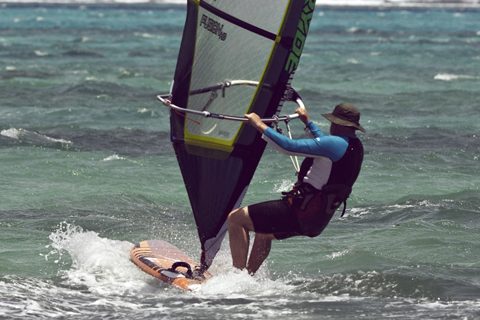
Day 3, a square metre less sail, 30 litres less volume and 5 knots more wind (now a magic force 5) and he’s sailing like a small person, standing tall, on the toes, giving to the power and letting the rig pull him upright and flatten the board off. Having less ‘grunt’ encouraged him into a far better stance.
PHOTO Hart Photography.
Their mindset kills it. They see themselves as big so they act big and play up to the role. They drop the shoulders and head and move like a dinosaur. I’ve started doing slalom again this year. I was always rubbish in the lighter winds because I told myself I was. This year I’ve said: ‘I can … and I can.’ Weight is just an excuse.”
Big man – think like a small person and above all do not get transfixed by a craving for more power
THE CHAIN OF IMPROVEMENT
This is how it works. Choose the kit. Target the wind strength that will make it work. Tune it so it works in that chosen wind strength. Then work on all aspects of set-up and stance that improve posture, efficiency and mobility. This is how it played out in real life with our chosen big men.
THE PROGRESS OF JOHN
We were in Tobago. The first 2 days were a thin 15 knots. John heads straight to the racks and nabs the biggest everything he could find – a 9.0 sq m free-ride and a robust 160. He never planed because he’d rigged the sail for maximum power. Yes, that’s right.
Obeying popular theory, he had released out and downhaul to bag the sail out to create those lower gears. With big men especially, that just doesn’t work. With tensions slackened, the leech tightens and traps the wind. You get a huge tugging sensation, like an umbrella, but because the air isn’t releasing, that power is all sideways drag. The leech is trying to open but can’t. The sail is effectively starved of cloth.
Instead they need to predict what will happen to the sail. The mast will bend more under the load of big men, so they must increase the downhaul to to pre-bend the mast and let the sail breathe (or ‘gasp’ in this case).
Whitey: “In light wind slalom I use the same size sail as the lighter guys; I just use a lot more downhaul. It’s the same with outhaul. Letting it right off makes a knuckle shaped foil, which produces more drag than lift. You have to make the sail efficient – not just powerful.”
JOHN – SHAPED BY THE RIG
Bagged out monster sails have shaped John’s stance. It’s been all about winning a tug o’ war contest. As he sheets in, he anticipates the surge by digging in and dropping under the boom. It’s reasonable advice for a small person resisting a big sail but that same action just makes a heavy man even heavier. As he drops down, still hooked out, the weight falls onto his heels, the windward edge sinks, the fin can’t work and he heads up and loses drive. As a way to induce planing he heaves on both arms, which sinks the tail and produces a tsunami-esque bow wave. Watching John trying to plane was like watching a JCB trying to pull a steamroller out of the mud – colossal drag and huge contradictory forces.
“I was taught to sit down and dig in.” He says. “That’s not right is it?!”
The other crucial element is fatigue. Not quite planing hooked out with a huge rig, not quite waterstarting, continual uphauling, is physically gruelling. When you lose muscle power and core tension, you effectively gain another 10 kg. Back on land we retuned the sail. It was better. He had short release moments but basically the sheer size of everything has been stopping him from refining his technique.
“ Big riders need to be attentive to trim, especially when the wind is light … more downhaul tension … will turn a truck (hard to close down, gusts forcing the rig to stand) into a sled ” Monty Spindler – designer Loft sails.
A NEW WINDIER DAY DAWNS …
Day three the wind had eased up to 20 knots – force 5 = perfect. As John heads for the shore with a spring in his step, I tap-tackle him, wrench the monster kit from his vice-like northern grasp and replace it with a cam-less 7.5 and a tasty, new, light carbon 130 free-ride board. “But, but, but …” he moans. The video the night before revealed something interesting. On the plane John looks like Rudolf Nureyev. Off the plane he looks like Giant Haystacks (infamous 60’s chubby wrestler). As the board planes and stabilises, the apparent wind kicks in and the sail lightens up; he gradually stands up, relaxes and looks totally proficient and … relatively small. As he drops off the plane, he hunkers down again, into that squatting ‘you won’t get me,’ heel-heavy stance. The aim, I tell him, is that if we were to cut the picture off at the waist, we shouldn’t be able to tell whether he was on or off the plane. Although there was more wind, the smaller sail had less of that raw, defence-inducing grunt, so we could work on that light man’s posture – tall, arms extended, head and hips lifted, pelvis tilted, guts sucked up under ribcage, stomach taught, toes down.
Four major changes occurred on that glorious Caribbean day.
1. He hooked in straight away, before he planed, to shore up the middle section and get a steady flow of power into the board. It takes huge strength for a big man to get planing out of the harness.
2. He narrowed his hand grip. Big, catapult unfriendly sails had forced him to spread them and place the front hand well forward on the boom, which pulled his body forward over his feet and sunk the board. Just by moving the front hand back, his hips dropped behind his feet and he could drive the board forward. And by narrowing the grip he became more sensitive to the trim of the smaller sail.
3. The smaller, lighter sail provoked a change of attitude from resisting power to giving to it and letting it pull him forward, upright and onto the edge of a catapult, whereupon the board levelled off and slid to glory.
4. To start with what delighted him most was improved waterstarts. Before he’d heave himself up using the massive sail like a bar. Using the ‘giving to the power’ notion, he extended rather than pulled and rose up in the sailing position already moving.

Harty on SIZE Little and large alike are often over-sailed and over-volumed because they don’t realise how much you can shed when the wind reaches the magic force 5. In Tobago my regular combo wasa 109 fsw and a 6.5. If I was planing, it was touching a force 5. I told John he needed a max of 20 litres. and 1 sq. m. more than me. If it’s more he can only be struggling. Early planing on smaller kit is 5 seconds of effort for a session of glorious lightness.
Generally big men aren’t good off the plane in light winds because … they don’t sail off the plane in light winds. Having spent his early life pirouetting on an original Windsurfer, Mark bucks this trend. The very best things big men can do to improve is to sail their chosen planing board in marginal breezes with a smaller sail, so they find out where they can and can’t tread, and learn NOT to rely on a tractor of a rig to hold them up. For Mark it was also a confidence issue. A 160 is almost a ‘sinker’ for him but he uphauled and tacked it and now heads to open waters with no trepidation.
 Onshore set-up test. Big men must use the harness to plane – but it only works if the lines are long enough to allow them to step back and leave the rig forward.
Onshore set-up test. Big men must use the harness to plane – but it only works if the lines are long enough to allow them to step back and leave the rig forward. PHOTO Hart Photography.
 Mark tacking semi-submerged with a ballerina’s agility. After this shot we worked on moving the rig out of the way on an extended arm before stepping round …
Mark tacking semi-submerged with a ballerina’s agility. After this shot we worked on moving the rig out of the way on an extended arm before stepping round …PHOTO Hart Photography.
 and eliminating the old school habit of sheeting in with the front hand on the mast, which made him lean forward, pressure the front foot and lose the nose.
and eliminating the old school habit of sheeting in with the front hand on the mast, which made him lean forward, pressure the front foot and lose the nose.PHOTO Hart Photography.
Less is More …
Shedding 30 litres of volume down to the 130 was a challenge to start with but made him much more sensitive to foot pressure. Without thick rails to absorb heavy feet, he could feel how easily lazy trim could make the board push water and increase drag. A more relaxed, efficient off-the-plane stance gave him more speed. And with every extra knot the board effectively gains a few litres.
The upshot was that the smaller combo planed a lot earlier because it was lighter and allowed to him sail properly. It was also less tiring, so he fell in less. With more energy he was quicker to waterstart and so stayed upwind and felt like bearing away. Hollywood could not have planned it better – he finished the afternoon with a dry carve gybe.
It’s been primarily about rig choice. Big sails are hard to pump. There’s a slow motion delay between sheeting in and feeling the leech open, close and drive you forward. So they breed inactivity and the mentality of “I’ll just sit back wait to be pulled along.” John spent a lot of time being pulled along not quite fast enough. The smaller rig encouraged him to be light and dynamic.
Huge rigs will ultimately be useful and widen the planing window of big men. But only once they’ve acquired cute trimming skills.
Big rigs – The Skill Killers
“ The primary mistake big guys make is to try and learn with big rigs (9.0 plus). Going really big on the sail just adds weight – and that can sink the board too deep and stop you getting going ”
Dave White
MARK’S PROGRESS
Mark had been away from windsurfing for 2 years, so the first priority was to help him tool up in a contemporary way. His 3 sails, a 9.4 twin cam, an 8.0 and 6.5 rotationals were fine – but he needed a modern early planing board. He fancied a 140 Freemove but was fearful of becoming an RNLI statistic. With his 140 kgs and a big rig, he would be in negative buoyancy territory should the wind desert him. He plumped for a 160 Freemove. The outlines of these modern shapes don’t change so much with the sizes, they just get thicker. So if in doubt, going bigger is usually the right decision.
Our first and so far only session was in 11-15 knots over waist deep flat water. Mark was desperate to get going and reached immediately for the 9.4 – until I pointed out that our Olympic Ladies, on big boards using 8.5’s and weighing exactly 80 kg less than him, would only just be planing so what chance would he have even on a 9.4?
A lot of big man angst is just down to unrealistic expectations regarding planing. They need huge, expensive, racy well-tuned kit matched by an equally skilled body to plane in a force 4. Wind pressure increases exponentially relative to wind speed to the point where a force 5 generates nearly twice as much power as a force 4. 18-20 knots therefore is the target winds that allow them to plane on sensible size kit. This was the time to rig the 8.0, obey the early Whitey training module and just float around and breed confidence on the board he wants to sail in strong winds.
THE WATERSTART FACTOR
Waterstarting is the big man’s nemesis because they’re often on whopping, full, cambered sails, which are a beast to recover from the water. The saviour lies in uphauling, which they don’t like either, mainly because they don’t practice it. The rule for all is, if you haven’t waterstarted in 15 seconds, get on and pull!
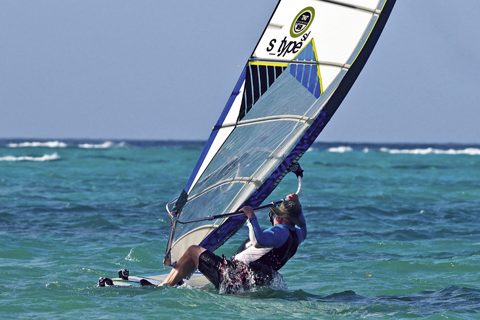
John’s waterstart technique reflecting his sailing technique of heaving against the power rather than going with the flow. It improved dramatically with the smaller sail where he found himself being pulled straight into the sailing position.
PHOTO Hart Photography.
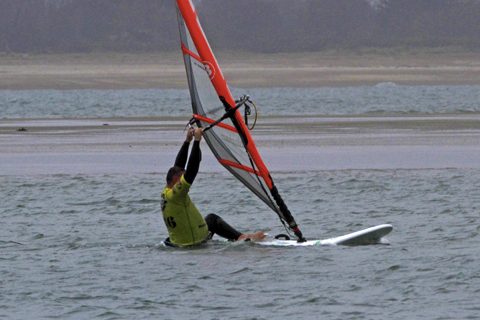
Mark stayed in this ‘nearly waterstarting’ pose for about 30 seconds and lost 50 metres downwind.
The uphaul was screaming at him demanding attention.
PHOTO Hart Photography
It doesn’t sound like the most dynamic session but for an hour Mark sailed off the plane, tried uphauling, succeeded (and immediately felt better about taking this same board offshore). He tested lines, sailed one handed, sailed on his toes, sailed upwind. He tacked – one in three to start with, getting better all the time – and he flare gybed. He learned where to put his feet. He came in smiling and realised how useful, physically, mentally, tactically and technically, a non-planing session can be.
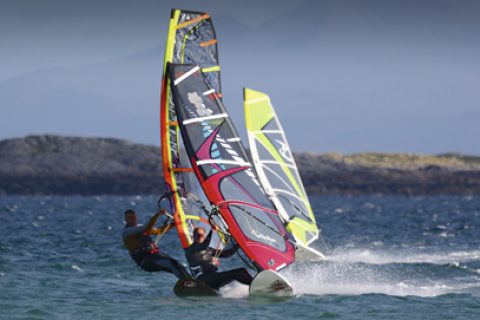
Harty and Whitey sparring in Tiree in 20 knots of breeze. Both are on 103 litre boards. Whitey is 25 kg heavier – it’s either down to sorcery or very sensitive feet.
PHOTO Richard Whitson.

The big man’s favourite error is getting heel heavy and sinking the windward rail, all too easy when the straps are outboard. Make life easy by locating them inboard and opening them right up. PHOTO Hart Photography.
Stage two – the set-up
Back on shore we prepared for the planing session. Mark’s size 16 feet were a worry. Early planing problems can be down to big men not being able to get their big feet in the straps and their heels being too far outboard, sinking the windward rail and dragging in the water.
We located them inboard, opened them right up and he shed the booties. The more easily he can slip into them the better, for which too big is way better than too tight.
For early planing, the harness set-up is key. As mentioned, Mark is from a different era. When boards were long with a continuous rocker, you stayed forward and gradually moved back as you accelerated and ‘rocked’ back onto a smaller and smaller area – and then eventually hooked into short lines and locked it all down.
His Free-move board is very different. The entry to the rocker is only just in front of the footstraps, behind which is the planing flat. So by standing forward too far and too long as you try to plane, you push a rockered section into the water and stop it planing.
The trick is to release the nose and initiate planing by stepping back but at the same time keeping mastfoot pressure. Stepping back is always a danger for big guys. On relatively small boards they can only do it by hooking into long lines so they leave the rig upright as they step back, and then pumping from the harness. In the same way, take a note of mastfoot position. Some big men put it forward to prevent a tail sink, but actually boom up and track back a little is the best way to get the nose up and make modern designs release early.

Harty encouraging John to breathe in and think small.
PHOTO Hart Photography.
His next purchase is a waist harness to help cure the sitting habit and free up his legs for easier waterstarting. I leant him my Large Da Kine T7. Didn’t quite fit round the 50 inch waist. I told him Whitey was his man…
Of his return journey to windsurfing, Mark has this positive message for the larger gentlemen.
“The check list of what I’ve learned is: longer lines, get away from the old nappy harness stance, more downhaul, hand further back on the boom, don’t be afraid to move back on the board earlier. Chin up, tits out and don’t fear the catapult. And big guys, if you’ve come back to windsurfing after families/breeding etc and have put on a few pounds, you might struggle with the kit you were on and get hacked off after a few runs. But what I’ve discovered is that there are new boards and new techniques to get you out there.”
But finally to men carrying a bit of weight, be aware there is still one course of action guaranteed to make you improve – lose some of it! And one last thing – in the interests of balance, there will be an article dedicated to those at the other end of the scale. My instinctive reaction to lightweights is, “don’t bother me with your problems.” However they do have their own issues, which I shall address just as soon as I find out what they are…
Harty has a fabulous new website www.peter-hart.com revealing news of everything windsurfing including spaces on up and coming clinics. Email him for his monthly newsletter on [email protected] or like his Peter Hart Masterclass page.


